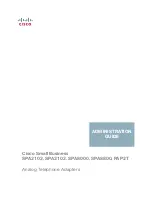
Time mode (day/lunch/break/night) of the preprogrammed tenant is applied to the DID destination and
company greeting number.
PBX
Tenant 1
123-4567
(Company A)
Tenant 2
(Company B)
CO Line Call
Extn. 105
Extn. 102
VPS
(Floating Extn. No. 500)
Intercept
123-2468
CO Line Call
Sends the following information:
·
VM Trunk Group: 1
·
Time mode: Day
Sends the following information:
·
VM Trunk Group: 2
·
Time mode: Lunch
8.
Caller’s Identification Notification to the VPS
When receiving a CO line call, the PBX sends the caller’s identification number/name to the VPS.
9.
DID Number Notification to the VPS
When receiving a CO line call with a DID number, the PBX sends the DID number to the VPS. The number
will be sent to the VPS even if the call reaches the VPS after redirection by, for example, the Intercept
Routing feature.
10.
Status Notification to the VPS
After the call is redirected by the VPS, the PBX sends the status of the redirected extension (e.g., busy)
to the VPS.
11.
Paging by the VPS
The VPS can perform the Paging feature using the recorded message. (
®
12.
Live Call Screening (LCS)
A PT or PS user can monitor his own mailbox while a caller is leaving a message and, if desired, answer
the call by pressing the LCS button. When the caller is leaving a message in the mailbox, monitoring can
be carried out in two ways: each PT user can choose which through personal programming (Live Call
Screening Mode Set). PS users cannot choose the way: only Private mode is available for them.
Hands-free mode:
The user can monitor the call automatically through the built-in speaker.
Private mode:
The user will hear a warning tone. To monitor the call, the user goes off-hook with the
handset, MONITOR button, or SP-PHONE button. However, PS users cannot monitor the call with the
speakerphone.
®
6.1 [4-1-1] Wired Extension—Extension Settings—Option 1—
13.
Two-way Recording into the VPS
A PT user can record a conversation into his own mailbox or another mailbox, while talking on the phone.
The Two-way Record button is used to record into one’s own mailbox. The Two-way Transfer button is
used to record into someone else’s mailbox.
368
Feature Manual
Document Version 2013-05
19.1.4 Voice Mail DPT (Digital) Integration
Summary of Contents for KX-NCP500
Page 13: ...Section 1 Features and Configurations A Document Version 2013 05 Feature Manual 13...
Page 27: ...Section 2 Features and Configurations B Document Version 2013 05 Feature Manual 27...
Page 30: ...30 Feature Manual Document Version 2013 05 2 1 1 BGM Background Music...
Page 31: ...Section 3 Features and Configurations C Document Version 2013 05 Feature Manual 31...
Page 75: ...Section 4 Features and Configurations D Document Version 2013 05 Feature Manual 75...
Page 100: ...100 Feature Manual Document Version 2013 05 4 1 12 Doorphone Call...
Page 101: ...Section 5 Features and Configurations E Document Version 2013 05 Feature Manual 101...
Page 112: ...112 Feature Manual Document Version 2013 05 5 1 9 External Sensor...
Page 113: ...Section 6 Features and Configurations F Document Version 2013 05 Feature Manual 113...
Page 135: ...Section 7 Features and Configurations G Document Version 2013 05 Feature Manual 135...
Page 140: ...140 Feature Manual Document Version 2013 05 7 1 1 GROUP FEATURES...
Page 141: ...Section 8 Features and Configurations H Document Version 2013 05 Feature Manual 141...
Page 149: ...Section 9 Features and Configurations I Document Version 2013 05 Feature Manual 149...
Page 185: ...Section 10 Features and Configurations L Document Version 2013 05 Feature Manual 185...
Page 193: ...Section 11 Features and Configurations M Document Version 2013 05 Feature Manual 193...
Page 204: ...204 Feature Manual Document Version 2013 05 11 1 5 Mute...
Page 205: ...Section 12 Features and Configurations O Document Version 2013 05 Feature Manual 205...
Page 212: ...212 Feature Manual Document Version 2013 05 12 1 5 Operator Features...
Page 213: ...Section 13 Features and Configurations P Document Version 2013 05 Feature Manual 213...
Page 296: ...296 Feature Manual Document Version 2013 05 13 1 32 PT Programming...
Page 297: ...Section 14 Features and Configurations Q Document Version 2013 05 Feature Manual 297...
Page 301: ...Section 15 Features and Configurations R Document Version 2013 05 Feature Manual 301...
Page 307: ...Section 16 Features and Configurations S Document Version 2013 05 Feature Manual 307...
Page 332: ...332 Feature Manual Document Version 2013 05 16 1 10 Syslog Record Management...
Page 333: ...Section 17 Features and Configurations T Document Version 2013 05 Feature Manual 333...
Page 354: ...354 Feature Manual Document Version 2013 05 17 1 6 TRS Toll Restriction...
Page 355: ...Section 18 Features and Configurations U Document Version 2013 05 Feature Manual 355...
Page 357: ...Section 19 Features and Configurations V Document Version 2013 05 Feature Manual 357...
Page 379: ...Section 20 Features and Configurations W Document Version 2013 05 Feature Manual 379...
Page 388: ...388 Feature Manual Document Version 2013 05 20 1 5 Wireless XDP Parallel Mode...
Page 389: ...Section 21 Appendix Document Version 2013 05 Feature Manual 389...
Page 415: ...Index Document Version 2013 05 Feature Manual 415...
Page 421: ...Document Version 2013 05 Feature Manual 421 Notes...

































